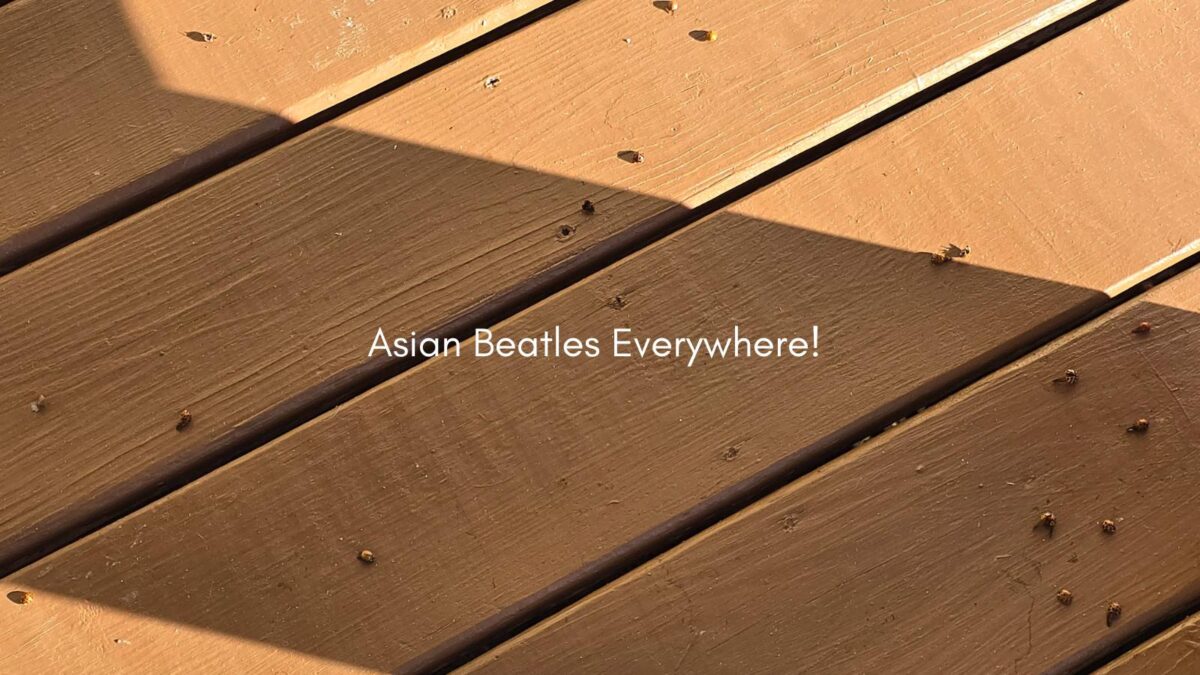October light hits our windows, and there they are—dozens of orange specks, slow and stubborn, warming on the glass. Living rurally, we’ve learned this is the season when Asian lady beetles look for shelter. The nights turn cold, and they stream toward sunny walls and cozy cracks.
If you’re seeing the same, you’re not alone. Asian lady beetles in Maine arrive in clusters right when we want to seal up for winter.
They resemble ladybugs but behave like houseguests with strong opinions. Over the past few years, we’ve learned how to handle them without stress—knowing that their season is short helps.
We’ll share what these beetles are, why they swarm our homes, and easy ways to keep peace. The goal is simple. Identify, prevent, and gently remove, then get back to enjoying fall.
What Makes Asian Lady Beetles Show Up in Our Maine Homes
Asian lady beetles are not the same as our native ladybugs. They are usually brownish orange, not bright red. Many have black spots. The easiest clue is the minor white marking on the head that often looks like an M. They’re also a bit bigger and can bite if bothered, though that’s rare.
Their life cycle explains the fall rush. They feed on aphids through the summer, especially around fields and gardens. When temperatures drop, they look for warm places to spend the winter.
Maine’s cold nights in October push them toward sunlit siding, attic vents, and window frames. On bright days, we see the Asian lady beetles in Maine pile up on white paint or glass. They’re not breeding indoors. They’re only trying to overwinter, then they leave again when spring settles in.
These Asian lady beetles in Maine often release a musty scent when stressed. That odor signals other beetles, which is why they return to the same spots year after year.
The multicolored asian lady beetle can also leave yellow stains on paint or curtains. That is why we never crush them. Vacuuming or trapping works better and keeps the smell down.
It helps to tell them apart from helpful native ladybugs. Look for the orange color, a larger body, and that pale M on the head. If we crack a window to usher them out on a warm day, we can keep both our house and our gardens happier.

Signs of an Asian Lady Beetle As They Get Into Maine Houses
- Small groups gathering on south-facing walls in the afternoon sun
- Clusters around windows, porch lights, or glass storm doors
- A strong, musty odor if one gets crushed
- Yellow streaks on light walls or curtains
- Activity near attic vents, soffits, and wall voids, especially in October
- Beetles tapping at ceiling lights or skylights inside on sunny winter days
We do quick checks once the leaves start to drop. Attics, window trim, and basement sill plates are worth a look. Early action keeps the number of Asian lady beetles in Maine smaller.
Why These Asian Lady Beetles Love Maine’s Rural Areas Right Now
Our open fields and wood edges grow summer food for these beetles. Aphids thrive on wild plants and crops, which means the beetles do too.
By fall, their numbers rise, then the first frost sends them searching for warm, bright surfaces. October is prime time. A warm, sunny afternoon after a cold night brings a sudden wave.
Weather shifts change the number of sightings we have each year. A long, warm fall means more late-season activity. A quick cold snap prompts them to hurry inside.
Some years are light, others are heavy. Rural areas, with more edge habitat and less sealed construction, see more of these asian beetle visitors. They are like the mayflies of the springtime season.
Safe Ways to Keep Asian Lady Beetles in Maine Outside Without Harsh Chemicals
We focus on prevention, then gentle removal. It keeps our home clean and protects beneficial insects outside.
- Seal entry points. Caulk gaps around window trim, siding joints, and utility lines. Use weatherstripping on doors to achieve a tight fit, and repair flashings where insects can sneak into soffits.
- Fix and upgrade screens. Replace torn mesh on windows, vents, and attic openings. Fine-mesh screen helps on gable vents.
- Improve door sweeps. A stiff, well-fitted sweep blocks the slow crawlers that follow sunlight inside.
- Light management. At night, switch to yellow bug bulbs outdoors. Motion lights reduce the constant glow that attracts insects.
- Vacuum smart. A hose vacuum is our first choice for indoor removal. Use a bag or stocking insert so we can take it outside and empty right away. This avoids odor and stains.
- Soapy water traps. A spray bottle with mild dish soap and water knocks them down safely. It also helps with cleanup on windows or siding.
- Avoid squishing. Crushing releases a foul scent and can mark paint and fabrics.
- Keep the yard tidy. Store firewood away from the house, trim back plants that touch the siding, and rake up leaf piles that attract pests near the foundation.
- Block hidden routes. Seal around attic access, light fixtures, and baseboard gaps where they wander from wall voids.
If indoor numbers still seem overwhelming, consider calling a local professional who uses integrated pest management. Request targeted, low-toxicity options and exterior treatments that minimize entry without harming pollinators.
We have found a local pest control company that comes to spray right before the season kicks in.
Daily Habits to Stop Beetles from Coming In
- Turn off outdoor lights at night, or use yellow bug lights
- Close curtains on sunny windows to reduce indoor heat cues – we also like to turn up our AC unit.
- Check dryer vents, bathroom vents, and fan housings for gaps
- Do a quick sweep each evening around doors and windows with a vacuum
- Keep a small soapy spray bottle handy for window frames
- Vacuum them, and if you leave the vacuum in the house, use duct tape to avoid them getting out.
These habits take minutes and save hours later.
When to Call for Help with Big Infestations
It is time to call for help if we see hundreds entering despite the steps above, if beetles pour out of attic vents or light fixtures daily, or if we notice heavy staining on walls and drapes.
Ask for Maine services that practice integrated pest management. Look for exterior sealing, limited spot treatments, and timing that protects beneficial insects. A good service will focus on the building envelope first, then treat it with care.
Tips for Peaceful Coexistence with Asian Lady Beetles in Maine
We remind ourselves that these visitors are seasonal. They help control aphids outdoors in spring and summer. They do not chew wood.
They do not carry diseases. Indoors, they mainly rest in quiet corners until the warm sun wakes them up.
On mild afternoons, we sometimes relocate them. A jar and a thin card work well. We carry them to the sunny side of a shed or a stone wall. It becomes a small ritual that helps keep the house calm and prevents strong smells.
To support our gardens, we plant and mulch in ways that welcome native predators and pollinators. Healthy gardens attract native ladybugs and syrphid flies, which effectively control pests. We keep flowering herbs like dill and cilantro, and let some plants bolt for nectar. This spreads out the pest control work and reduces our reliance on sprays.
A gentle mindset helps. We are not fighting a war. We are coaching a seasonal shuffle so our home stays clean and our land stays alive.
Fun Facts About These Beetles That Might Change Your View
- They were introduced to the United States decades ago to help control crop pests, then spread widely on their own.
- Many have a pale M on their head shield, a quick field mark for identification.
- They release a strong scent when stressed, which signals other beetles. That is why they return to the identical houses year after year.
- They can nip, but it is more of a pinch than a bite. However, we try to keep our dog away from them as she would carry them into our bed.
- They do not breed inside our homes. They overwinter, then return outdoors with the spring warmth.

Do asian lady beetles in Maine eat ladybugs?
Yes, Asian lady beetles sometimes eat other ladybugs. Their primary food source is aphids and other soft-bodied pests, but they also engage in intraguild predation.
They will eat ladybug eggs, larvae, and even injured adults, especially when food is scarce in late summer or fall. This habit, along with their high numbers, puts pressure on native ladybug species. In rural homes, they often gather indoors to overwinter, which makes them hard to ignore.
To protect native beetles, focus on promoting plant diversity, avoiding the use of broad-spectrum insecticides, and sealing gaps around siding and windows.
Conclusion: Enduring Maine’s Lady Beetles
Fall in Maine brings sunlit windows, crisp air, and sometimes, a crowd of orange beetles. We can handle it better with a simple plan. Identify the visitors, seal the gaps, and remove them gently, remembering their role outside. Asian lady beetles in Maine are a seasonal reality for rural homes, not a crisis.
Share your stories in the comments. What works in your farmhouse, camp, or new build to prevent Asian lady beetles in Maine? We are building a library of rural tips together. We will continue to cover the bugs and quirks of country life, so check back for more fall and winter guides. Thanks for spending part of your day with us.
